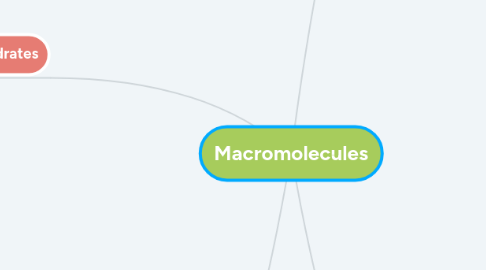
1. Carbohydrates
1.1. Formula: CH2O
1.2. main source of energy in living organisms
1.3. sugars (usually (NOT ALL) end in -ose)
1.3.1. MONOMERS
1.3.1.1. monosaccharides
1.3.1.1.1. simplest sugars (one molecule)
1.3.2. POLYMERS
1.3.2.1. disaccharides
1.3.2.1.1. double sugars (2 linked monosaccharides) AKA oligosaccharides
1.3.2.2. polysaccharides
1.3.3. beta sugars cannot be digested by the human body
1.3.3.1. Chitin is an example of a polymer containing beta sugar linkages
1.3.3.1.1. provides rigid, yet flexible exoskeleton for animals such as arthropods
1.3.4. alpha sugars can be digested by the human body
1.4. condensation reaction (dehydration synthesis
1.4.1. building of macromolecules (anabolism)
1.4.1.1. energy is required
1.5. hydrolysis reaction
1.5.1. breaking down macromolecules (catabolism)
1.5.1.1. enzymes (special proteins) involved as a catalyst
1.5.1.1.1. energy is released
2. Nucleic Acids
2.1. small packages of energy: ATP
2.1.1. composed of Adenosine, 3 phosphate groups and ribose sugar
2.1.2. ATP is a product of cellular respiration
2.2. RNA: Ribonucleic acid
2.3. POLYMERS: DNA and RNA
2.3.1. DNA: Deoxyribosenucleic acid
2.3.1.1. Orientation: antiparallel
2.4. MONOMERS: Nucleotides
2.4.1. Adenine
2.4.2. Thymine
2.4.3. Cytosine
2.4.4. Guanine
2.4.5. Uracil
2.5. Purine: double ring (A, G)
2.6. Pyrimidine: single ring (C, T, U)
2.7. Other Uses
2.7.1. hereditary/genetic info
2.7.2. involved in making proteins
2.7.3. co-factors in reactions
2.7.4. energy carriers
2.7.5. internal cell signaling
3. Proteins
3.1. MONOMERS: Amino Acids (make up protein)
3.1.1. 9 essential (must get from food)
3.1.1.1. valine, leucine, isoleucine, phenylalanine, tryptophan, lysine, arginine, histidine, methionine, threonine
3.1.2. 11 non-essential (body makes these)
3.1.2.1. alanine, arginine, asparagine, aspartic acid, cysteine, glutamic acid, glutamine, glycine, proline, serine, tyrosine
3.1.3. Polar are also considered hydrophilic; ability to interact with water
3.1.4. Non-polar are also considered hydrophobic; inability to interact with water
3.1.5. contain R group, amine group, carboxyl group
3.1.6. bonding of amino acids forms a peptide bond; new structure is a DIPEPTIDE
3.2. POLYMERS: Polypeptides
3.2.1. long chains of amino acids
3.2.2. Primary structure: linear sequence
3.2.3. Secondary structure: primary structure folds from H bonding between peptide bonds
3.2.3.1. alpha helix
3.2.3.2. beta sheets
3.2.4. Tertiary structure: further folding (from intermolecular forces) to create its 3D shape
3.2.5. Quaternary structure: combination of more than one protein with folded tertiary structures
3.3. Other Uses
3.3.1. enzymes
3.3.2. structural proteins
3.3.3. signaling proteins
3.3.4. regulatory proteins
3.3.5. transport proteins
3.3.6. sensory proteins
3.3.7. motor proteins
3.3.8. defence proteins
3.3.9. storage proteins
4. Lipids
4.1. long term energy storage, insulation, hormonal roles, protection, structural components
4.2. Amphipathic; contains both hydrophobic and hydrophilic parts
4.2.1. Micelle: hydrophobic lipid ends facing inward and the hydrophilic phosphate end faces outwards
4.2.1.1. phospholipids make the phospholipid bilayer
4.2.1.1.1. membranes that help control what goes in and out of a cell is described as a fluid mosaic
4.3. hydrophobic (insoluble in water)
4.4. Triglycerides
4.4.1. made up of glycerol and fatty acids
4.4.1.1. Saturated fatty acids
4.4.1.1.1. have only single bonds
4.4.1.1.2. rigid with no bends
4.4.1.1.3. packed closely together: solid @ room temp
4.4.1.2. Unsaturated fatty acids
4.4.1.2.1. monounsaturated: one double bond
4.4.1.2.2. polyunsaturated: multiple double bonds
4.4.1.2.3. bent, not rigid
4.4.1.2.4. cannot pack closely together: liquid @ room temp
4.4.1.2.5. Trans fats
4.4.1.2.6. cis (H's between double bond on same side)
4.4.1.2.7. trans (H's between double bond on opposite sides)
4.5. Sterols
4.5.1. AKA asteroids
4.5.1.1. compact hydrophobic molecules
4.5.1.2. contain 4 hydrocarbon rings
4.5.1.3. cholesterol is an example of a sterol
4.5.1.3.1. vital to cell membranes
4.5.1.3.2. high cholesterol leads to multiple diseases
4.6. waxes
4.6.1. contains long chains of fatty acids linked to alcohol or carbon rings
4.6.2. hydrophobic , firm, pliable consistency
4.6.2.1. these properties makes waxes waterproof to protect internal parts
4.6.2.1.1. cutin is an example of a wax produced by epidermal cells of animals

